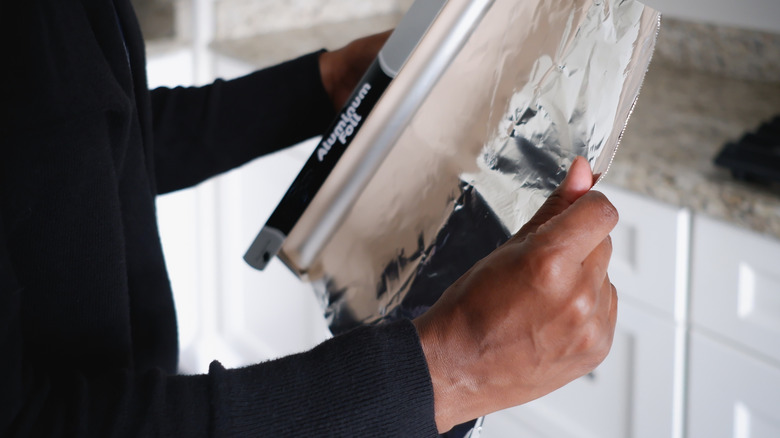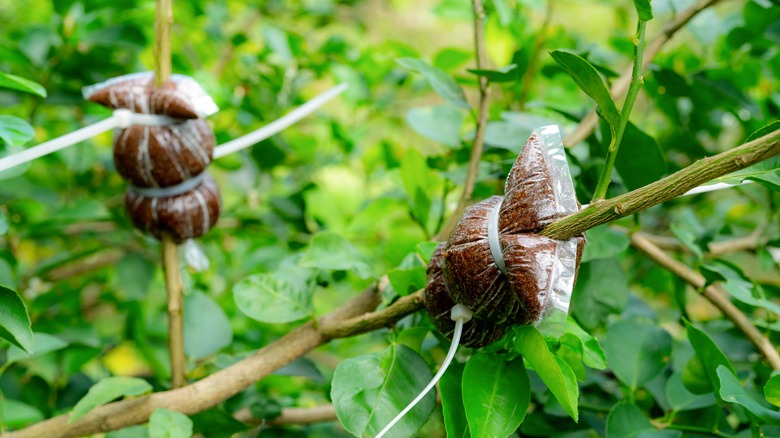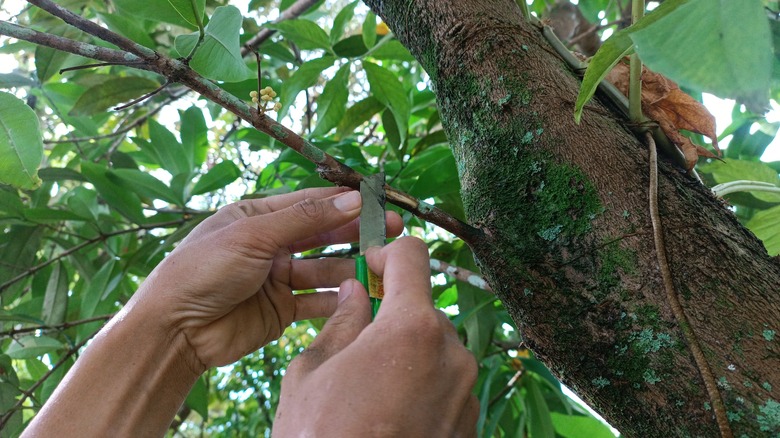How To Use Aluminum Foil To Make Layering Plants In The Garden A Breeze
While you might be familiar with popular propagation methods using seeds or cuttings, another way you can create new plants from the ones you already have growing is to use layering. There are many benefits to using layering as a propagation because you don't need any special tools or controlled environments to produce new plants. According to the Oklahoma State University Extension, layering requires much less space and is ideal for plants that may not be easy to propagate using other methods. There are various layering methods used in propagation, including simple layering, tip layering, compound layering, mound layering, and air layering.
Aluminum foil is most useful when using the air layering method. This is commonly done on fruit trees that might otherwise be difficult to propagate from seeds or cuttings. It can also be used on other types of trees and shrubs that have woody growth such as ornamental figs, magnolias, camellias, and azaleas. While this method is a little more involved than other methods such as simple layering, it can be made easier by using aluminum foil to protect the wound made on the branch from light and thus, encourage the roots to grow faster. Air layering can also be used to propagate indoor plants such as rubber plants, Dracaenas, and Dieffenbachia. You might be interested in learning what to know about air layering your indoor plants.
How aluminum foil helps when air layering
When using the air layering method, you're trying to encourage a branch of the plant to produce its own roots. You do this by wounding a small section of the branch and then covering the wound with damp sphagnum moss or damp coco coir which is a much more sustainable product. You can learn more about peat moss vs coco coir to find out why the latter is being recommended more often now. The plant will respond by growing roots from the wounded section. The wounding effectively limits the transportation of carbohydrates down to the existing roots of the plant. This means that these carbohydrates will accumulate around the wound and stimulate the branch of the plant to produce its own roots.
You'll need to ensure that this covered section is not exposed to light because this will inhibit root growth. That's where aluminum foil can be very beneficial because it has reflective qualities that will reflect the sunlight away from the wrapped section. When the wounded section of the plant is protected from light and covered with the damp sphagnum moss, it's much more likely that roots will start to form from the wound. Plus, the aluminum foil will protect the young roots from getting scalded by the sunlight. It also helps to keep the sphagnum moss in place and should prevent it from drying out as well, but you might need to check it periodically to ensure that it's still damp.
How to use aluminum foil when air layering
To begin your air layering, you want to select a tree with a lower branch that's within reach. Choose a healthy branch that's around 1 to 2 inches in diameter. Using a clean sharp knife, make a vertical cut in the branch around 12 inches from the tip. This cut should be at least 1 to 2 inches long. Make two horizontal cuts, one at the top of the vertical cut and one at the bottom. These should go all the way around the branch. Gently peel the outer bark away around the entire branch between the two horizontal cuts. Scrape back the cambial tissue under the bark to prevent callusing.
Wrap the cut area completely with moist sphagnum moss or coco coir. Then, wrap the aluminum foil around the moss to keep it in place. The entire wrapped section should be about the size of a baseball. You can secure the foil with rubber bands or twist ties. You now just have to wait for roots to grow, which could take up to a year. Once you can see evidence of root growth, you can safely cut the branch from the tree just below the wound, unwrap the foil and plant your new tree into a pot or another spot in your garden. This is just one of the clever ways to use aluminum foil in the garden.


